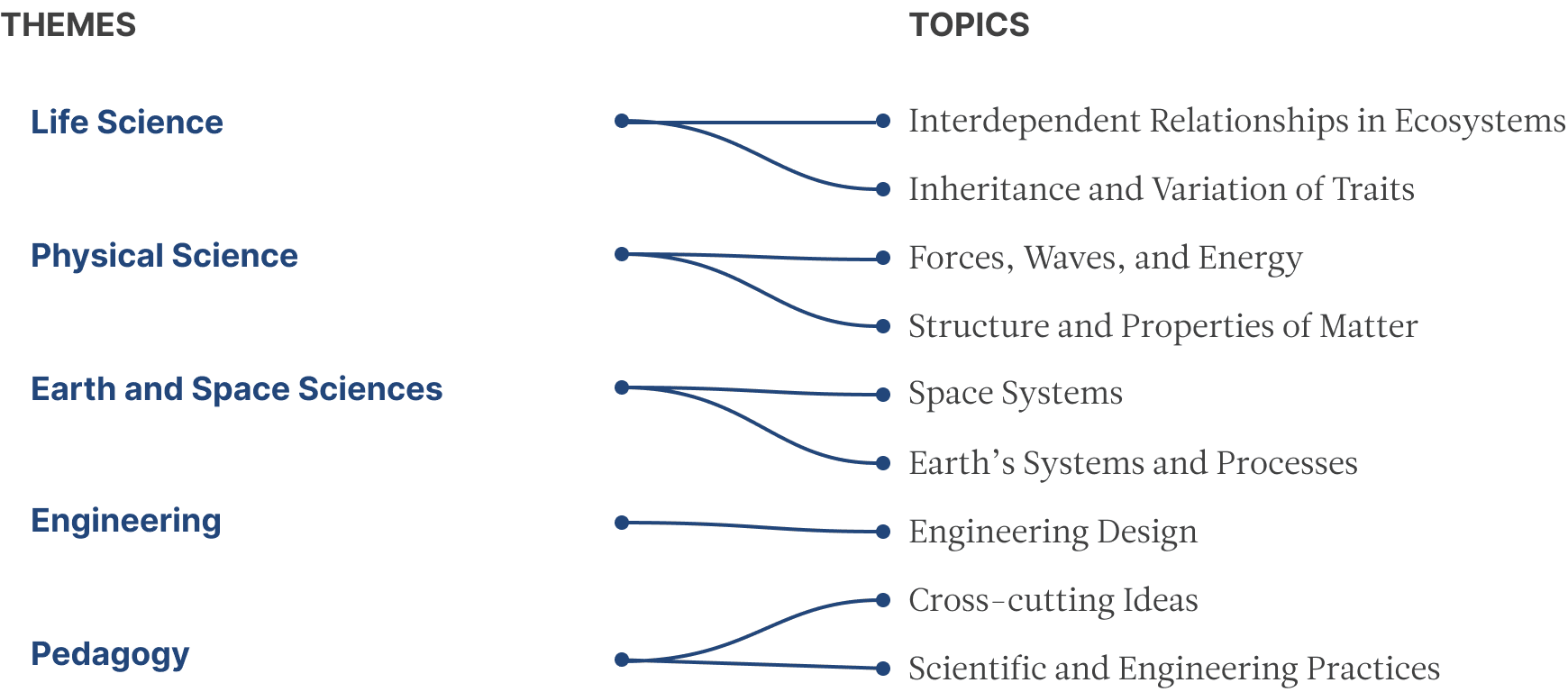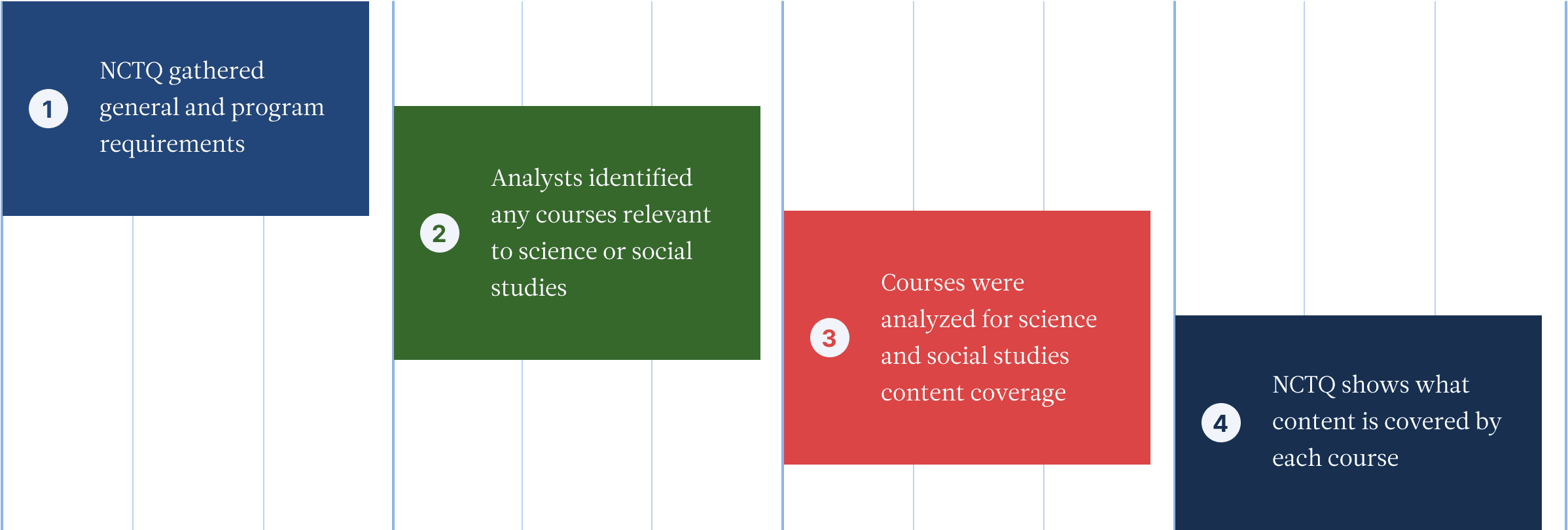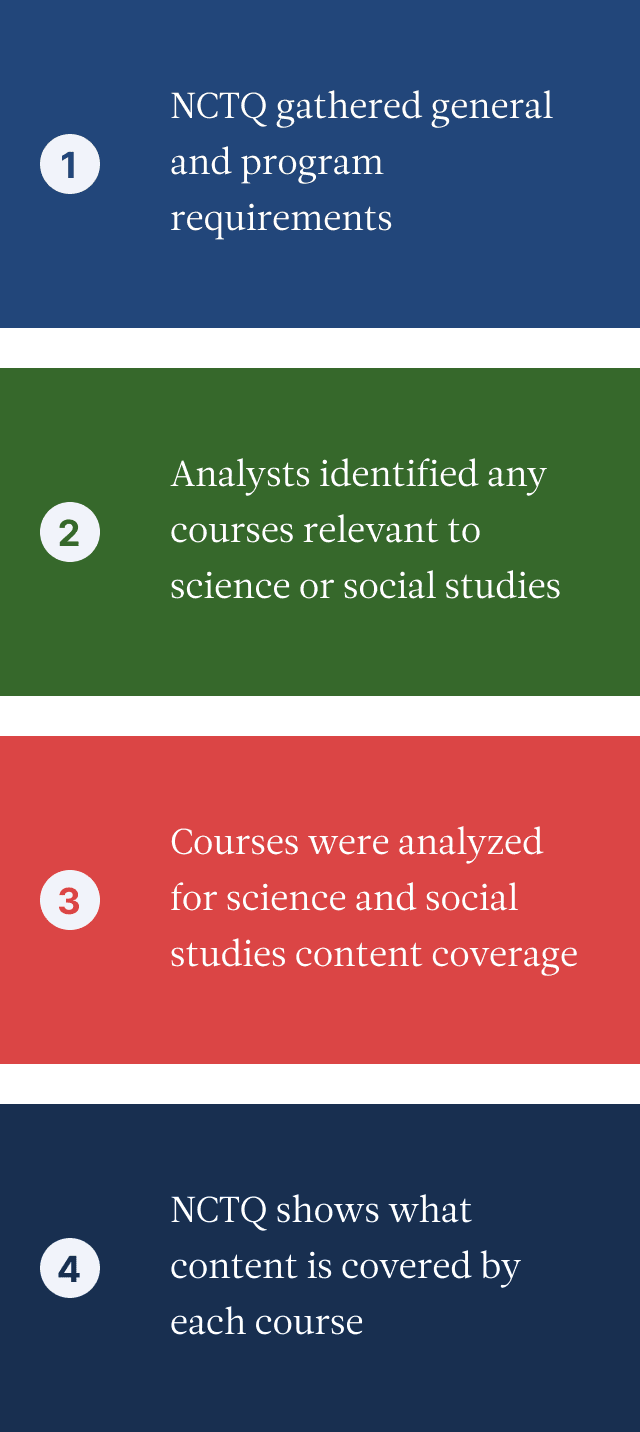West Virginia University
Here is a personalized summary of the current course requirements and recommendations for undergraduate elementary teacher candidates at West Virginia University, and a detailed analysis of the content covered by those requirements. This tool also offers a recommended set of courses providing the most content coverage for any candidate.
Catalog Year: 2021-2022
West Virginia University
This tool provides individual preparation programs with a customized analysis of the courses required by the undergraduate elementary teacher preparation program and by the institution’s undergraduate general education courses to determine how well these requirements cover essential content in science. This tool also uses information about existing coursework on their campuses to provide guidance on a recommended course sequence.
This is a summary of the coverage of science content for undergraduate elementary candidates at your institution.
To determine if an elementary teacher preparation program provides adequate coverage¹ in the primary subject area of science through its own requirements or the institution’s requirements, we ask three sequential questions exploring:
- Evidence of any science coverage;
- Evidence of coverage of the three science themes; and
- Evidence coursework encompasses the nine topics of science knowledge required of elementary teachers.
West Virginia University's Coverage
Coverage of Subject
Does the institution or teacher preparation program require elementary candidates complete any courses in science?
The institution/program recommends or requires candidates to complete at least one course classified under the broad domain known as science.
The institution/program does not require or recommend candidates to complete at least one course classified under the broad domain known as science.
Theme Coverage
Within science, there are five themes. Does the institution or teacher preparation program require or recommend courses to ensure each of the themes classified under science are covered?
The coursework required or recommended for elementary candidates at this institution covers all five themes in science: 1. Life Science, 2. Physical Science, 3. Earth and Space Science, 4. Engineering, and 5. Pedagogy.
The coursework required or recommended for of elementary candidates at this institution does not cover all five themes in science: 1. Life Science, 2. Physical Science, 3. Earth and Space Science, 4. Engineering, and 5. Pedagogy.
Topic Coverage
Within the five themes of science are nine topics common to teaching elementary students. Does this institution or preparation program require or recommend courses to ensure each of the nine topics classified under science are covered?
Elementary education candidates at this institution must complete at least one course covering each of the nine topics.
Elementary education candidates at this institution are not required to take courses covering each of the nine topics.
What are the nine topics of Science content?

References
- For these purposes, credit for “coverage” is awarded to the program whether the course is mandated through general education requirements for the institution at large or the specific requirements of the educator preparation program.
This tool illuminates:
- What course options are available to satisfy general education or teacher preparation Requirement Categories;
- What courses are required or recommended, either through general education requirements or the teacher preparation program; and
- Whether courses cover the themes and topics of science content knowledge.
The aim of this tool is to provide an understanding of which courses are most likely to yield the most coverage possible of the content critical for elementary teachers. Because candidates can often choose from a list of courses to meet a Requirement Category, this table provides insight into which of those courses will be most relevant to elementary teaching.
How are Requirements Determined?
Analysts identify both the general education and program graduation requirements found in public-facing materials.
By reviewing each Requirement Category and available course options, analysts identify courses addressing science and social studies content relevant to elementary teachers. The course analysis table indicates what themes and topics each course covers.


West Virginia University's Content Coverage Analysis
Filter Course Options By Requirement Category
| Themes: | Pedagogy | Life Science | Physical Science | Earth & Space Sciences | Engineering | ||||
|---|---|---|---|---|---|---|---|---|---|
| Topics (hover to see name): |
ACross-cutting Concepts |
BScientific and Engineering Practices |
CInterdependent Relationships in Ecosystems |
DInheritance and Variation of Traits |
EForces, Waves, and Energy |
FStructure and Properties of Matter |
GSpace Systems |
HEarth's Systems and Processes |
IEngineering Design |
Extensive ListInstitution offers ten or more course options to fulfill requirement. Courses shown cover at least one applicable topic. |
|||||||||
BIOL 115/116Principles of Biology/Laboratory |
|||||||||
BIOL 105/106Environmental Biology/Laboratory |
|||||||||
BIOL 101/103General Biology/Laboratory |
|||||||||
BIOL 102/104General Biology/Laboratory |
|||||||||
Continue Reading
See the recommended course sequence for your institution.
Here NCTQ outlines (1) the set of courses providing candidates with the content most aligned with what elementary teachers need within current institution and program requirements, and (2) suggestions for courses to fill in gaps where candidates still lack coverage.
"Most Aligned" Set of Courses
-
Science Requirement 01
BIOL 115/116 - Principles of Biology/Laboratory
-
Science Requirement 02
PHSC 101 - Introductory Physical Science
-
Science Requirement 03
PHSC 102 - Introductory Physical Science 2
-
Science Requirement 04
EDUC 440 - Elementary-Early Childhood Science Methods
How to Improve Content Coverage
Using the “Most Aligned” Set of Courses, current course requirements can address up to 77.78% coverage of science topics.
The topics still lacking coverage include:
- Scientific and Engineering Practices
- Engineering Design
To improve content coverage, the institution or teacher preparation program may need to require additional courses for their candidates to achieve coverage across all topics. Our analysts identified the following courses to cover these topics:
- Scientific and Engineering Practices: No applicable courses found in NCTQ's analysis
- Engineering Design: No applicable courses found in NCTQ's analysis
Analysis of Content Covered by "Most Aligned" Set of Courses
= Course is Currently Recommended or Required by Program
Download Recommendations| Themes: | Pedagogy | Life Science | Physical Science | Earth & Space Sciences | Engineering | ||||||||
|---|---|---|---|---|---|---|---|---|---|---|---|---|---|
| Topics (hover to see name): |
ACross-cutting Concepts |
BScientific and Engineering Practices |
CInterdependent Relationships in Ecosystems |
DInheritance and Variation of Traits |
EForces, Waves, and Energy |
FStructure and Properties of Matter |
GSpace Systems |
HEarth's Systems and Processes |
IEngineering Design |
||||
BIOL 115/116Principles of Biology/Laboratory |
|||||||||||||
PHSC 101Introductory Physical Science |
|||||||||||||
PHSC 102Introductory Physical Science 2 |
|||||||||||||
EDUC 440Elementary-Early Childhood Science Methods |
|||||||||||||
| Total Content Covered: 77.78% | |||||||||||||
If a candidate takes the above courses, this is the topic coverage they would experience overall: |
|||||||||||||
Catalog Year: 2021-2022
West Virginia University
This tool provides individual preparation programs with a customized analysis of the courses required by the undergraduate elementary teacher preparation program and by the institution’s undergraduate general education courses to determine how well these requirements cover essential content in social studies. This tool also uses information about existing coursework on their campuses to provide guidance on a recommended course sequence.
This is a summary of the coverage of social studies¹ content for undergraduate elementary candidates at your institution.
To determine if an elementary teacher preparation program provides adequate coverage² in the primary subject area of social studies through its own requirements or the institution’s requirements, we ask three sequential questions exploring:
West Virginia University's Coverage
Coverage of Subject
Does the institution or teacher preparation program require elementary candidates complete any courses in social studies?
The institution/program recommends or requires candidates to complete at least one course classified under the broad domain known as social studies.
The institution/program does not require or recommend candidates to complete at least one course classified under the broad domain known as social studies.
Theme Coverage
Within social studies, there are six themes. Does the institution or teacher preparation program require or recommend courses to ensure each of the themes classified under social studies are covered?
The coursework required of elementary candidates at this institution covers all six themes in social studies: 1. Civics, 2. Economics, 3. History, 4. Geography, 5. Culture & Identity, and 6. Pedagogy.
The coursework required of elementary candidates at this institution does not cover all six themes in social studies: 1. Civics, 2. Economics, 3. History, 4. Geography, 5. Culture & Identity, and 6. Pedagogy.
Topic Coverage
Within the six themes of social studies are thirteen topics common to teaching elementary students. Does this institution or preparation program require or recommend courses to ensure each of the thirteen topics classified under social studies are covered?
Elementary education candidates at this institution must complete at least one course covering each of the thirteen topics.
Elementary education candidates at this institution are not required to take courses covering each of the thirteen topics.
What are the thirteen topics of Social Studies content?
References
Continue Reading
See a detailed course analysis for your institution.
This tool illuminates:
The aim of this tool is to provide an understanding of which courses are most likely to yield the most coverage possible of the content critical for elementary teachers. Because candidates can often choose from a list of courses to meet a Requirement Category, this table provides insight into which of those courses will be most relevant to elementary teaching.
How are Requirements Categories Determined?
Analysts identify both the general education and program graduation requirements found in public-facing materials.
By reviewing each Requirement Category and available course options, analysts identify courses addressing science and social studies content relevant to elementary teachers. The course analysis table indicates what themes and topics each course covers.
View the Course Catalog
West Virginia University's Content Coverage Analysis
Filter Course Options By Requirement Category
Identity
A
Political institutions, Participation, Rules, and Laws
B
Economic Principles and Exchange
C
The Economy
D
European Exploration and Colonization (up to 1700)
E
The American Revolution and Founding (1700s)
F
Growth and Expansion of the American Republic (up to 1900)
G
Twentieth Century and Beyond
H
Pre-Columbian and/or Ancient Civilizations
I
Twentieth Century and Beyond
J
Geographic Representations
K
Human-Environment Interactions
L
Diverse Perspectives
M
Cross-cutting Concepts
Extensive List
Institution offers ten or more course options to fulfill requirement. Courses shown cover at least one applicable topic.
Extensive List
Institution offers ten or more course options to fulfill requirement. Courses shown cover at least one applicable topic.
Extensive List
Institution offers ten or more course options to fulfill requirement. Courses shown cover at least one applicable topic.
Extensive List
Institution offers ten or more course options to fulfill requirement. Courses shown cover at least one applicable topic.
Extensive List
Institution offers ten or more course options to fulfill requirement. Courses shown cover at least one applicable topic.
Extensive List
Institution offers ten or more course options to fulfill requirement. Courses shown cover at least one applicable topic.
Extensive List
Institution offers ten or more course options to fulfill requirement. Courses shown cover at least one applicable topic.
Extensive List
Institution offers ten or more course options to fulfill requirement. Courses shown cover at least one applicable topic.
BIOL 115/116
Principles of Biology/Laboratory
BIOL 105/106
Environmental Biology/Laboratory
BIOL 101/103
General Biology/Laboratory
BIOL 102/104
General Biology/Laboratory
ASTR 106/107
Descriptive Astronomy/Laboratory
GEOL 101/102
Planet Earth/Laboratory
CHEM 111/L
Survey of Chemistry 1/Laboratory
PHYS 105
Conceptual Physics
PHSC 101
Introductory Physical Science
PHSC 102
Introductory Physical Science 2
ASTR 106/107
Descriptive Astronomy/Laboratory
GEOL 101/102
Planet Earth/Laboratory
CHEM 111/L
Survey of Chemistry 1/Laboratory
PHYS 105
Conceptual Physics
PHSC 101
Introductory Physical Science
PHSC 102
Introductory Physical Science 2
EDUC 440
Elementary-Early Childhood Science Methods
HIST 153
Making of Modern America: 1865 to the Present
HIST 152
Growth of the American Nation to 1865
ANTH 105
Introduction to Anthropology
POLS 103
Global Political Issues
HIST 180
World History Since 1500
HIST 179
World History to 1500
GEOG 102
World Regions
HIST 152
Growth of the American Nation to 1865
HIST 153
Making of Modern America: 1865 to the Present
HIST 180
World History Since 1500
HIST 179
World History to 1500
POLS 102
Introduction to American Government
GEOG 102
World Regions
BUSA 201
Survey of Economics
POLS 102
Introduction to American Government
CDFS 110
Families Across the Life Span
PSYC 241
Introduction to Human Development
EDUC 450
Issues and Methods for Teaching Elementary Social Studies
ENGL 255
Multiethnic Literature
HUM 101
Introduction to Western Civilization 1
Continue Reading
See the recommended courses for elementary candidates at your institution.
Here NCTQ outlines (1) the set of courses providing candidates with the content most aligned with what elementary teachers need within current institution and program requirements, and (2) suggestions for courses to fill in gaps where candidates still lack coverage.
"Most Aligned" Set of Courses
HIST 152 - Growth of the American Nation to 1865
HIST 180 - World History Since 1500
POLS 102 - Introduction to American Government
GEOG 102 - World Regions
BUSA 201 - Survey of Economics
EDUC 450 - Issues and Methods for Teaching Elementary Social Studies
ENGL 255 - Multiethnic Literature
How to Improve Content Coverage
Using the “Most Aligned” Set of Courses, current course requirements can address up to 84.62% coverage of social studies topics.
The topics still lacking coverage include:
To improve content coverage, the institution or teacher preparation program may need to require additional courses for their candidates to achieve coverage across all topics. Our analysts identified the following courses to cover these topics:
Analysis of Content Covered with "Most Aligned" Set of Courses
= Course is Currently Recommended or Required by Program
Download RecommendationsIdentity
A
Political institutions, Participation, Rules, and Laws
B
Economic Principles and Exchange
C
The Economy
D
European Exploration and Colonization (up to 1700)
E
The American Revolution and Founding (1700s)
F
Growth and Expansion of the American Republic (up to 1900)
G
Twentieth Century and Beyond
H
Pre-Columbian and/or Ancient Civilizations
I
Twentieth Century and Beyond
J
Geographic Representations
K
Human-Environment Interactions
L
Diverse Perspectives
M
Cross-cutting Concepts
HIST 152
Growth of the American Nation to 1865
HIST 180
World History Since 1500
POLS 102
Introduction to American Government
GEOG 102
World Regions
BUSA 201
Survey of Economics
EDUC 450
Issues and Methods for Teaching Elementary Social Studies
ENGL 255
Multiethnic Literature
If a candidate takes the above courses, this is the topic coverage they would experience overall:
Continue Reading